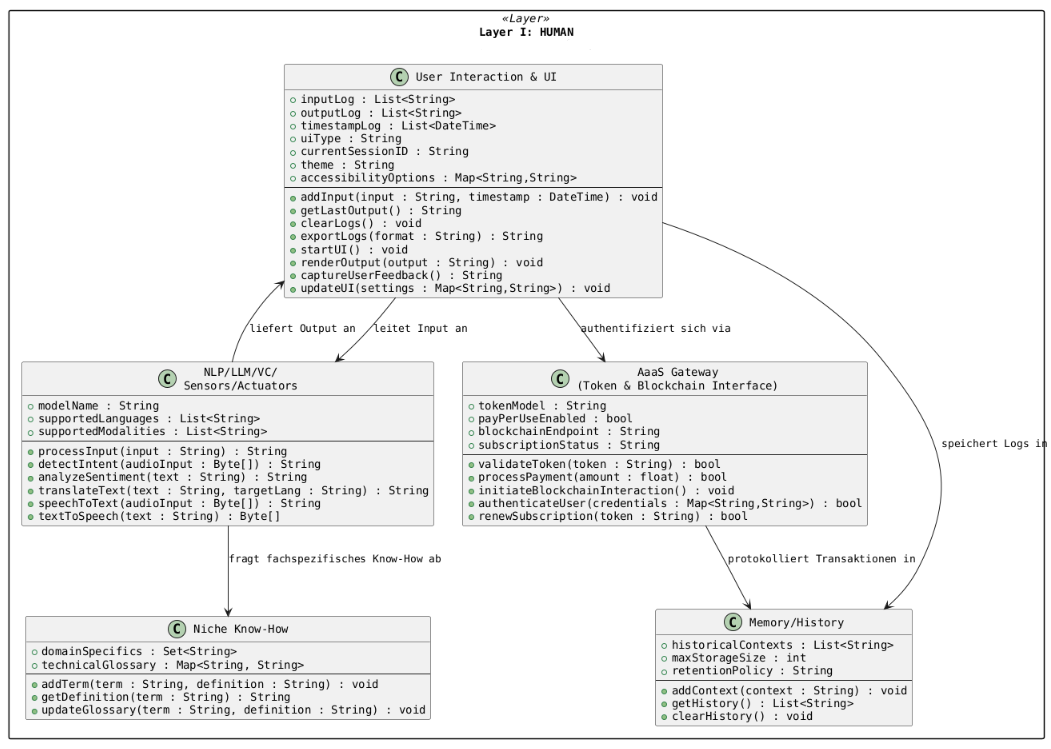AIAF consists of seven layers:
- Layer I: HUMAN
- Layer II: ROLES & TASKS
- Layer III: IT ARCHITEKTUR & INFRASTRUKTUR
- Layer IV: IMPLEMENTATION, TEST, DEVOPS
- Layer V: CORE INTELLIGENCE
- Layer VI: INTEGRATION & ECOSYSTEM
- Layer VII: PROJECT- AND MODEL GOVERNANCE
| Layer I: HUMAN | This layer captures all aspects of human-computer interaction, from user inputs and the user interface to sensor data and specialized domain knowledge. Additionally, the AaaS Gateway serves as an interface for token-based authentication and blockchain interactions, enabling the instantiation of specialized agents on the job. |
| Layer II: ROLES & TASKS | This layer organizes tasks, roles, and taxonomies, which determine which agents will take on specific tasks and how these tasks are classified and managed. |
| Layer III: IT ARCHITEKTUR & INFRASTRUKTUR | It encompasses the architecture, security concepts (cybersecurity), and network services that form the foundation of the entire system. |
| Layer IV: IMPLEMENTATION, TEST, DEVOPS | This layer provides development and deployment processes—including CI/CD, containerization, and pipelines—along with automated testing and quality control measures to ensure continuous integration and reliable operations. |
| Layer V: CORE INTELLIGENCE | This layer encompasses central AI components such as the knowledge base, data management, embeddings, language models (Human LLM), as well as machine learning and self learning. It forms the intellectual core of the system. |
| Layer VI: INTEGRATION & ECOSYSTEM | This layer connects the framework with external services, frameworks, transaction (token) mechanisms, and API gateways, enabling a seamless interplay between internal components and the outside world. |
| Layer VII: PROJECT- AND MODEL GOVERNANCE | This layer provides governance, project, and model management. It defines strategic visions and manages governance rules as well as quality and monitoring processes—often incorporating token-based mechanisms and external audits. |
Layer I – HUMAN
This layer serves as the interface to the human user. It processes user interactions, UI feedback, natural language processing (NLP), and specialized domain knowledge. Additionally, the AaaS Gateway handles token-based authentication and blockchain transactions.
| Class | Description |
|---|---|
| User Interaction & UI | Captures inputs, outputs, and timestamps; controls the user interface. |
| NLP/LLM/VC/ Sensors/Actuators | Processes text inputs, detects intentions, converts speech to text and vice versa, and supports multilingual capabilities. |
| Specialized Knowledge | Stores domain-specific terms and definitions to enhance NLP with specialized knowledge. |
| Memory/History | Stores historical contexts and log data for analysis and feedback. |
| AaaS Gateway (Token & Blockchain Interface) | Provides interfaces for token-based authentication, payment processing, and blockchain interactions, enabling on-demand agent instantiation. |
Key Interactions in Layer I:
- The user interface logs user inputs in the Memory/History.
- The AaaS Gateway authenticates the user and processes token transactions.
Layer II – TASKS & ROLES
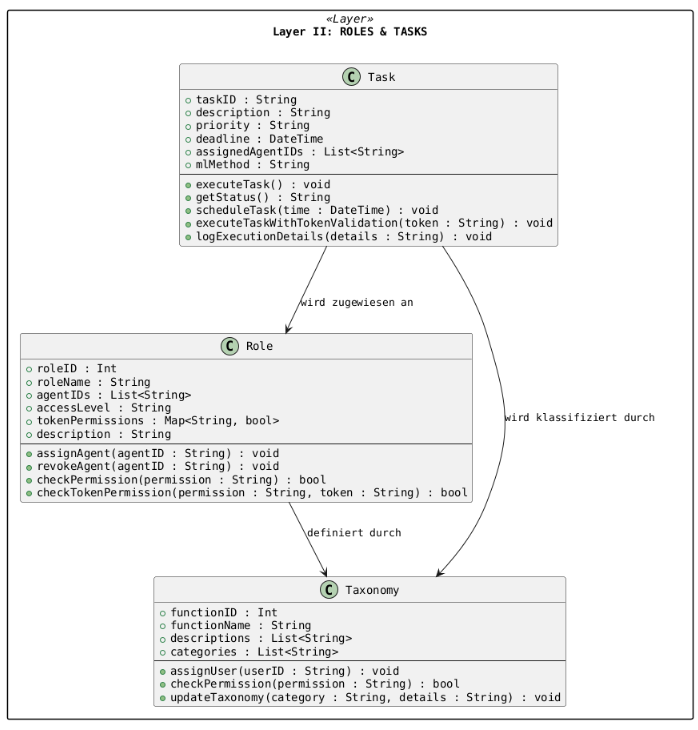
This layer defines tasks, assigns roles, and uses taxonomy for classification. It ensures that tasks are intelligently allocated to appropriate agents or human roles.
| Class | Description |
|---|---|
| Task | Defines tasks with priorities, deadlines, and the assignment of agents. |
| Role | Determines roles with specific access rights and token permissions. |
| Taxonomy | Classifies tasks and roles according to functions, categories, and descriptions. |
Key Interactions in Layer II:
- Tasks are classified using the taxonomy.
- Roles receive permissions and tasks are allocated accordingly.
Layer III: IT ARCHITEKTUR & INFRASTRUKTUR
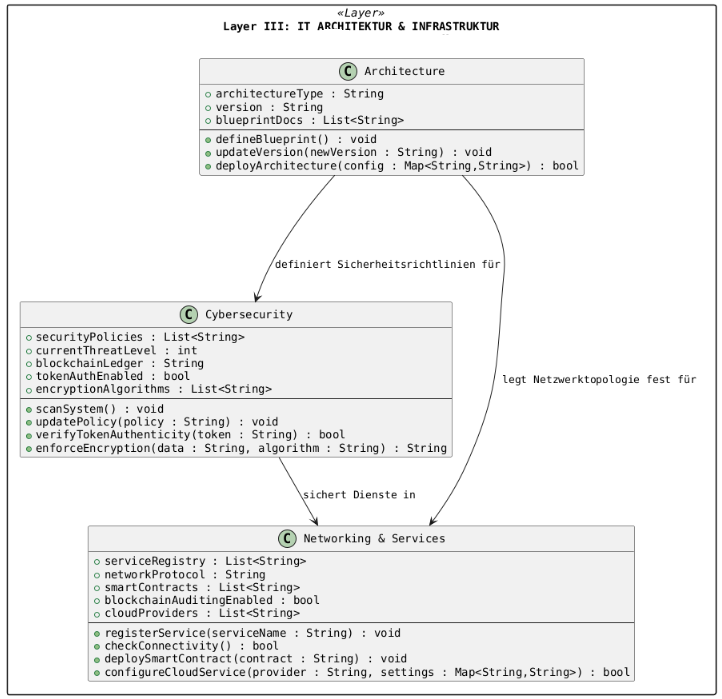
This layer forms the technical foundation. It includes system architecture, security policies, and network services essential for stable operation.
| Class | Description |
|---|---|
| Architecture | Defines the system’s architecture, versions, and blueprints. |
| Cybersecurity | Implements security policies, threat scanning, and token authentication. |
| Networking & Services | Manages the service registry, network protocols, and the deployment of smart contracts. |
Key Interactions in Layer III:
- The architecture sets the network topology for deployment processes.
- Cybersecurity performs security validations and token checks.
Layer IV: IMPLEMENTATION, TEST, DEVOPS
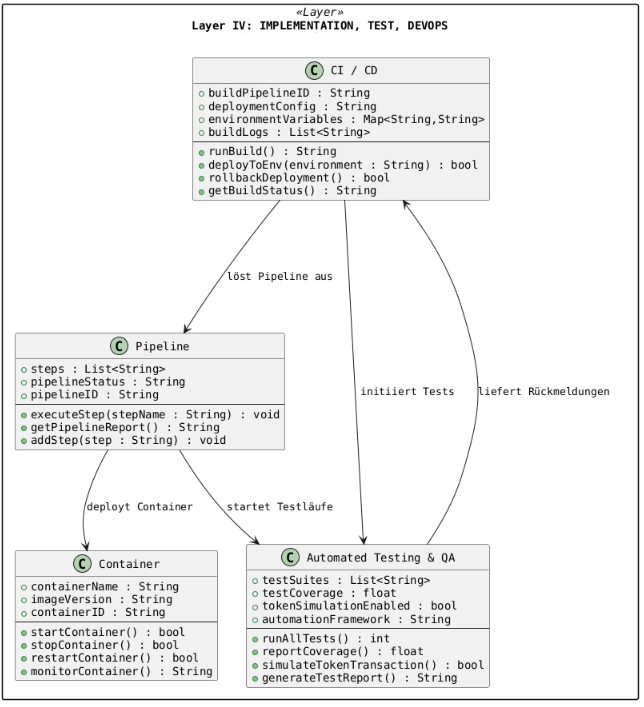
This layer addresses software development, continuous integration, deployment, and automated testing. It ensures that new versions are rolled out quickly and securely.
| Class | Description |
|---|---|
| CI / CD | Manages build pipelines, deployment configurations, and rollback processes. |
| Container | Starts and stops containerized applications. |
| Pipeline | Organizes the individual steps of deployment and monitors pipeline status. |
| Automated Testing & QA | Executes automated tests, measures test coverage, and generates test reports. |
Key Interactions in Layer IV:
- CI/CD triggers pipelines that deploy containers and initiate tests.
Layer V: CORE INTELLIGENCE
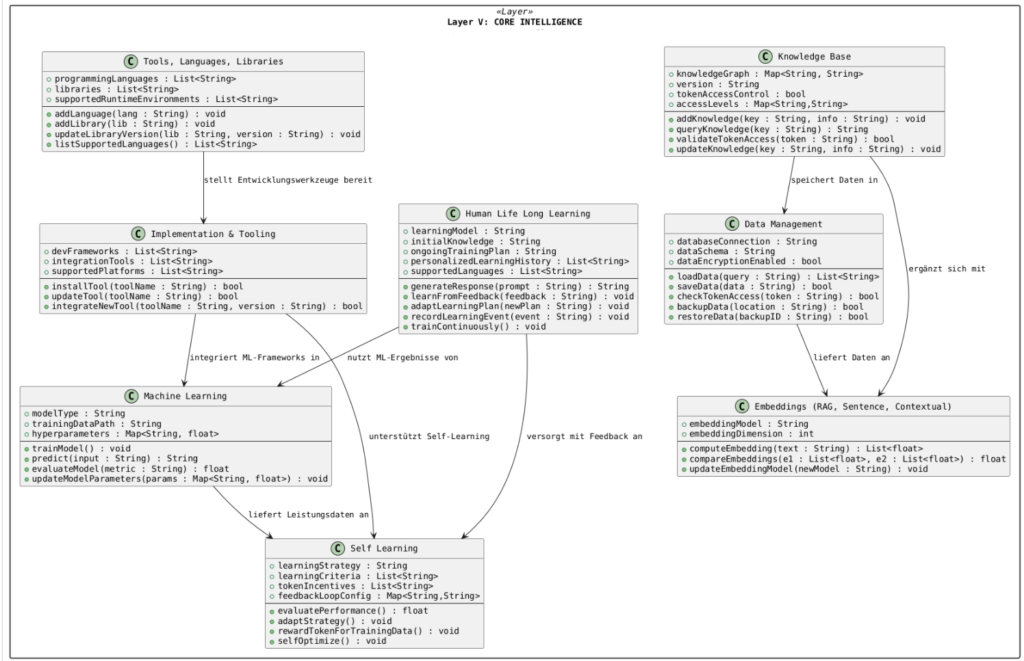
This layer focuses on central AI and data management components, including the knowledge base, machine learning, embeddings, language models, and self learning. It forms the intellectual heart of the system.
| Class | Description |
|---|---|
| Knowledge Base | Stores the knowledge graph, performs queries, and manages token-based access control. |
| Data Management | Manages databases and schemas and secures data through encryption. |
| Embeddings (RAG, Sentence, Contextual) | Computes text embeddings for semantic analysis and performance improvement. |
| Human LLM | Generates responses based on language models and continuously adapts. |
| Machine Learning | Trains models, makes predictions, and optimizes using machine learning methods. |
| Self Learning | Evaluates performance, adjusts strategies, and rewards training sessions using tokens. |
| Implementation & Tooling | Integrates development tools and supports the rollout of new tools. |
| Tools, Languages, Libraries | Manages programming languages, libraries, and supported runtime environments. |
Key Interactions in Layer V:
- Embeddings update the knowledge base, while self learning provides feedback loops for both LLM and ML.
- Development tools facilitate the integration of external resources.
Layer VI: INTEGRATION & ECOSYSTEM
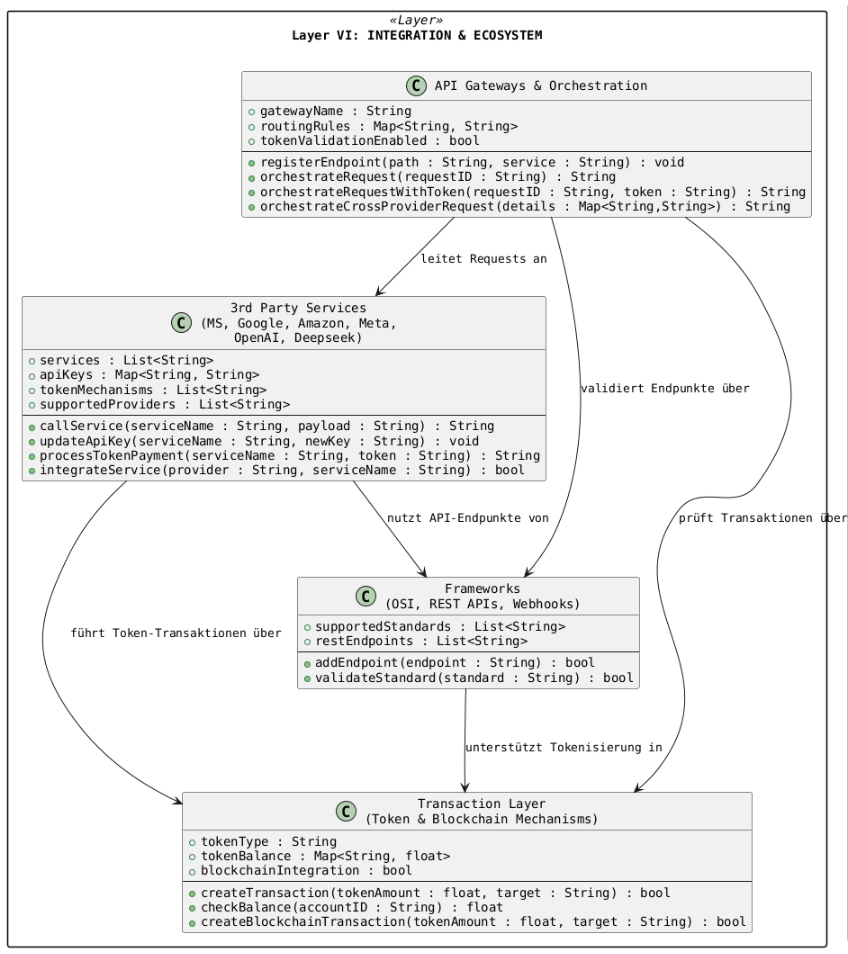
This layer connects the framework with external services. It includes interfaces to third-party services, frameworks, transaction (token) mechanisms, and API gateways, ensuring smooth data exchange.
| Class | Description |
|---|---|
| 3rd Party Services | Integrates external services (e.g., MS, Google, OpenAI, Amazon, Meta, Deepseek) and supports token payments. |
| Frameworks | Utilizes external API standards (OSI, REST APIs, Webhooks) for validation and endpoint control. |
| Transaction Layer (Token Mechanisms) | Manages token transactions, creates blockchain transactions, and checks account balances. |
| API Gateways & Orchestration | Coordinates requests, registers endpoints, and orchestrates requests while ensuring token validation. |
Key Interactions in Layer VI:
- External services are integrated via frameworks and API gateways.
- Token transactions support billing and access control.
Layer VII: PROJECT- AND MODEL GOVERNANCE
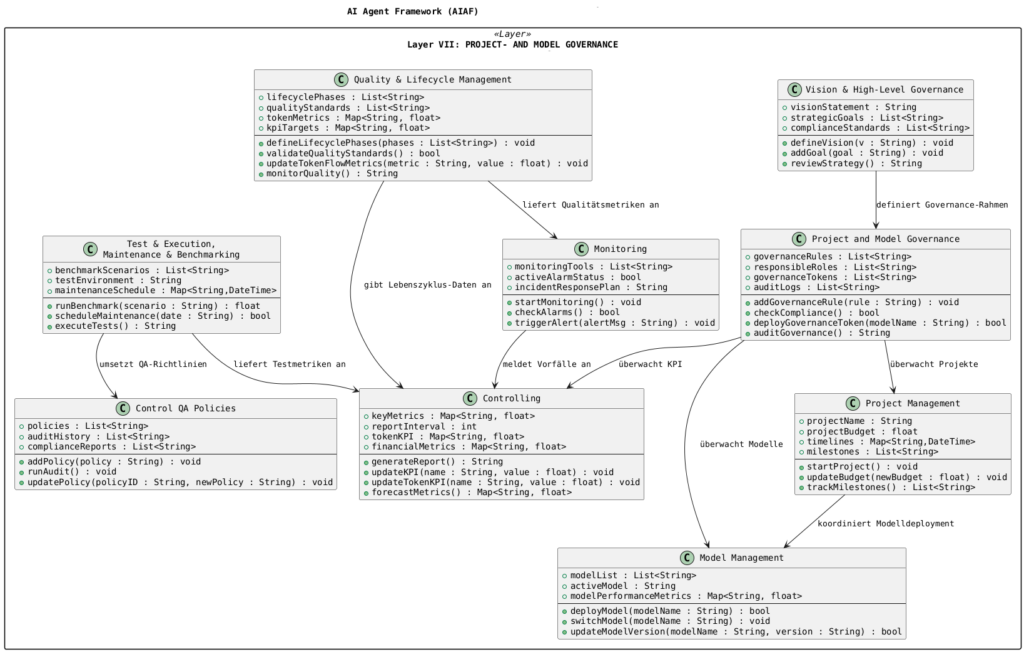
This layer provides governance, project, and model management. It defines strategic visions, sets governance rules, and manages quality and monitoring processes—often incorporating token-based mechanisms and external audits.
| Class | Description |
|---|---|
| Vision & High-Level Governance | Defines strategic vision, goals, and compliance standards. |
| Project and Model Governance | Establishes governance rules, assigns responsible roles, and utilizes governance tokens. |
| Project Management | Initiates and manages projects, budgets, timelines, and milestones. |
| Model Management | Oversees the lifecycle, deployment, and versioning of AI models. |
| Quality & Lifecycle Management | Sets quality standards, lifecycle phases, and monitors key performance indicators (KPIs). |
| Monitoring | Monitors the system, detects incidents, and triggers alerts. |
| Controlling | Generates reports, updates KPIs, and forecasts developments. |
| Test & Execution, Maintenance & Benchmarking | Conducts tests, schedules maintenance, and compares benchmark data. |
| Control QA Policies | Implements QA guidelines, conducts audits, and manages compliance reports. |
Key Interactions in Layer VII:
- Governance classes control project and model decisions using quality, monitoring, and KPI data.
- External audits and token-based mechanisms ensure compliance with strategic objectives.
Cross-Layer Interactions (Selected)
In addition to the internal relationships within each layer, the framework connects different layers to ensure data flows and control mechanisms:
| From (Layer) | To (Layer) | Interaction |
|---|---|---|
| Layer I | Layer II | UI data and user feedback initiate task creation and role identification. |
| Layer I | Layer III | The UI displays architecture status, security warnings, and network information. |
| Layer I | Layer V | Historical data and interaction logs feed into the knowledge base. |
| Layer II | Layer IV | Tasks trigger deployment processes and pipelines. |
| Layer III | Layer IV | Architecture blueprints and security policies drive CI/CD processes. |
| Layer V | Layer VI | Data management and embeddings support external API integrations. |
| Layer VI | Layer VII | External services, token transactions, and API gateways supply monitoring data for governance. |
Summary
The AI Agent Framework (AIAF) enables enterprises to:
- Efficiently capture and process human interactions (Layer I),
- Dynamically assign and manage tasks and roles (Layer II),
- Build a stable infrastructure (Layer III),
- Achieve continuous integration and reliable operations through development and testing (Layer IV),
- Operate an intelligent core using AI, data management, and self learning (Layer V),
- Seamlessly integrate external services and transactions (Layer VI), and
- Ensure strategic governance, quality, and project management (Layer VII).
Each table summarizes the core components and their interactions, providing a comprehensive view of the system—from the initial human interaction to strategic project governance.
